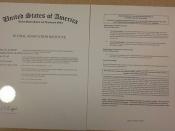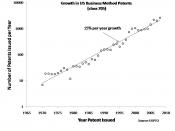Michael Strain Intellectual Property Law July 5, 2001 Mid-term Paper: State Street Bank and its effect on Patent Law All information in this paper comes from William J. Marsden, Jr. and J. Andrew Huffman, Feature: E-Boom or E-Bust? "Business Method"ÃÂ Patent and The Future of Dotcommerce, 18 Delaware Lawyer 18, (2000), and State Street Bank v. Signature Financial Group, 149 F.3d 1360 (Fed. Cir. 1998).
In E-Boom or E- Bust? "ÃÂBusiness Method' Patents and the Future of Dotcommerce, Marsden and Huffman argue that State Street Bank v. Signature Financial Group, 149 F.3d 1360 (Fed. Cir. 1998), caused a rush upon the U.S. Patent and Trademark Office (PTO). The evidence clearly supports such an argument. Before State Street Bank business methods were unpatentable, due to a judicial exclusion of methods of doing business. However, the court in State Street Bank, laid this exception to patent law to rest in 1998, holding, ""æA method of doing business can now constitute patentable subject matter."ÃÂ
William J. Marsden, Jr. and J. Andrew Huffman, Feature: E-Boom or E-Bust? "Business Method"ÃÂ Patent and The Future of Dotcommerce, 18 Delaware Lawyer 18, 19 (2000). This had to cause a rush on the PTO. A whole new area of commerce had become available to patent protection, a rush would be the only term sufficient to define the number of patent applications that would descend on the PTO.
Marsden and Huffman next argue that the Internet explosion also was effected by the court's finding in State Street Bank. The Internet revolves around commerce. Most sites have a way of generating money, whether it be one-stop-shopping or advertising. Many of these sites have used and/or will use business methods that are patentable because of the State Street Bank decision. Since patents can only give worth to an idea...


